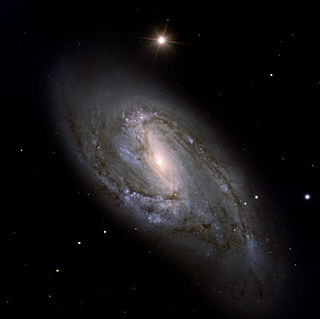Top Qs
Timeline
Chat
Perspective
Messier 66
Galaxy in the constellation Leo From Wikipedia, the free encyclopedia
Remove ads
Messier 66 or M66, also known as NGC 3627, is an intermediate spiral galaxy in the southern, equatorial half of Leo. It was discovered by French astronomer Charles Messier[8] on 1 March 1780, who described it as "very long and very faint".[9] This galaxy is a member of a small group of galaxies that includes M65 and NGC 3628, known as the Leo Triplet or the M66 Group.[10] M65 and M66 are a common object for amateur astronomic observation, being separated by only 20′.[9]
M66 has a morphological classification of SABb,[5] indicating a spiral shape with a weak bar feature and loosely wound arms. The isophotal axis ratio is 0.32, indicating that it is being viewed at an angle.[5] M66 is receding from us with a heliocentric radial velocity of 696.3±12.7 km/s.[3] It lies 31[4] million light-years away and is about 95 thousand light-years across[11] with striking dust lanes and bright star clusters along sweeping spiral arms.
Gravitational interaction from its past encounter with neighboring NGC 3628 has resulted in an extremely high central mass concentration; a high molecular to atomic mass ratio; and a resolved non-rotating clump of H I material apparently removed from one of the spiral arms. The latter feature shows up visually as an extremely prominent and unusual spiral arm and dust lane structures as originally noted in the Atlas of Peculiar Galaxies.[12]
Remove ads
Supernovae
Five supernovae have been observed in M66:
- SN 1973R (type II, mag. 14.5) was discovered by Leonida Rosino on 19 December 1973.[13]
- SN 1989B (type Ia, mag. 13) was discovered by Robert Evans on 30 January 1989.[14][15]
- SN 1997bs (type uncertain, mag. 17) was discovered by the Lick Observatory Supernova Search (LOSS) on 15 April 1997.[16][17] This event was initially classified as a type IIn supernova, but later analysis suggests that it is instead either a luminous blue variable,[18] a "gap" transient,[19] or a luminous red nova.[20]
- SN 2009hd (type II, mag. 15.8) was discovered by Libert (Berto) Monard on 2 July 2009.[21][22]
- SN 2016cok (type IIP, mag. 16.6) was discovered by the All Sky Automated Survey for Supernovae on 28 May 2016.[23][24][25]
Remove ads
Gallery
- Infrared false color view of M66 from the Spitzer Space Telescope
- Infrared false color view of M66 from the James Webb Space Telescope
- Messier 66 by 2MASS
- An ultraviolet image of Messier 66 by GALEX
See also
References
External links
Wikiwand - on
Seamless Wikipedia browsing. On steroids.
Remove ads





